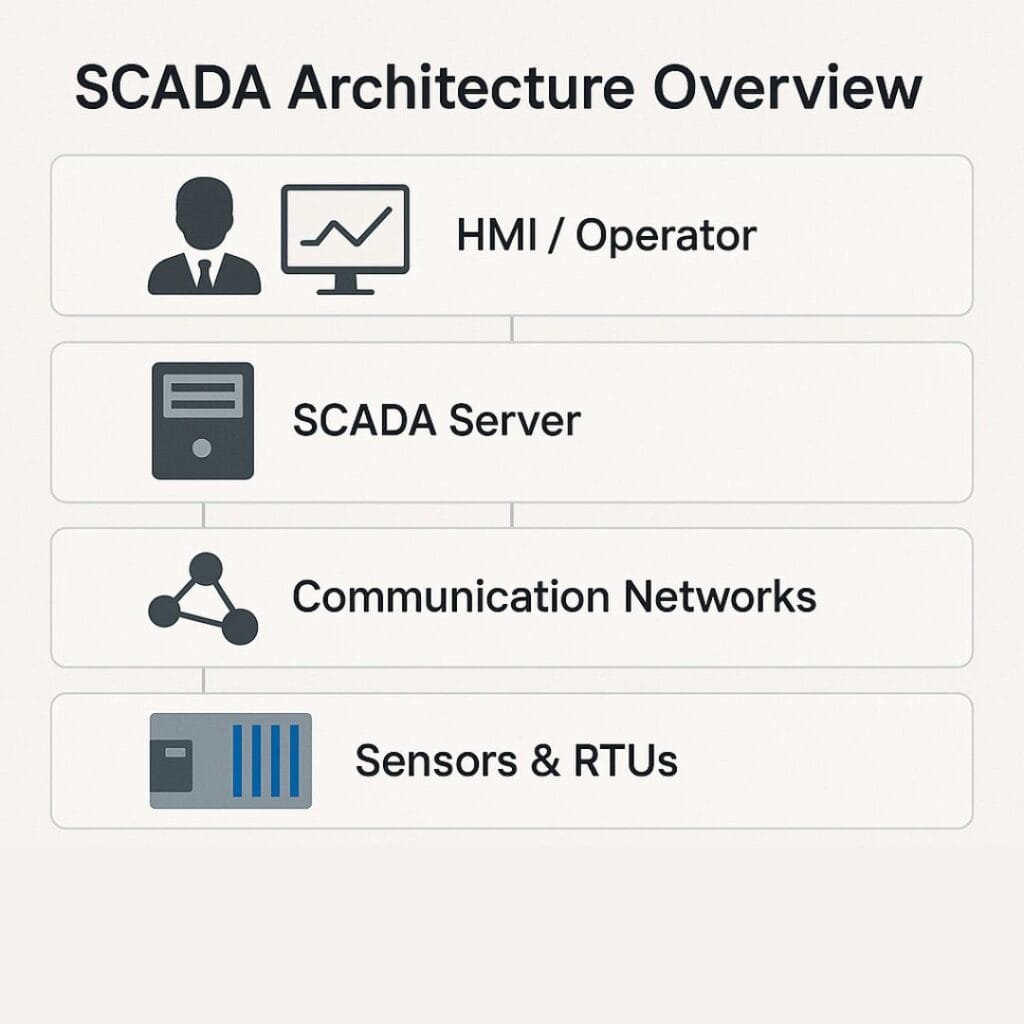Today, in a fast-changing industrial world, SCADA systems are really important for automation. They help organizations keep an eye on, control, and improve their processes right away. SCADA systems help connect data with decision-making, making things work better, keeping people safe, and making sure everything runs smoothly. This article looks at how important they are in today’s automation and how they are changing industries for the future.
What is SCADA?
SCADA is a system that helps keep an eye on and manage industrial processes from one central place. It combines sensors, Remote Terminal Units (RTUs) or Programmable Logic Controllers (PLCs), communication networks, and Human-Machine Interfaces (HMIs) to give operators a complete understanding of how the system is working. SCADA helps industries work smoothly and reliably by collecting and controlling data in real-time.

How Does a SCADA System Work?
A SCADA system monitors and controls industrial processes in real time by collecting data from devices like PLCs and sensors. This data is sent to a central server and displayed on an HMI, allowing operators to view system status, control equipment, and analyze performance. In Sri Lanka, SCADA is used in industries like solar power, water treatment, and tea processing.
Functions of SCADA Systems in Today’s Automation
1. Watching and Controlling Things as They Happen
SCADA helps people see what’s happening with important processes right away, so they can watch and manage machines and equipment as it happens. Being able to see things right away helps us respond faster, reduces the time things are not working, and makes sure everything runs really well.
2. Getting and Studying Data
SCADA helps people make decisions based on data by collecting information from sensors and connected devices. Looking at past and current data can help find problems, make things work better, and guess when something might go wrong.
3. Better Efficiency in Operations
SCADA helps to automate tasks that are done over and over again, makes fewer mistakes by people, and improves how work gets done. Things like controlling machines, checking quality, and making changes happen smoothly, which helps everything run faster and without mistakes.
4. Access and Control from a Distance
Modern SCADA systems let operators access them from far away, so they can watch and control processes no matter where they are. This feature cuts down the number of people needed on-site and helps us respond quicker to emergencies or problems.
5. Better Safety and Following Rules
SCADA makes workplaces safer by spotting dangerous situations, setting off alarms, and automatically shutting things down in emergencies. It makes sure everything follows the rules by keeping careful records and tracking everything that happens.
Key Benefits of SCADA Systems
- Cost Savings: SCADA systems help reduce downtime, cut energy use, and lower labor costs by automating processes and detecting issues early.
- Scalability: SCADA solutions can be expanded easily as operations grow, making them ideal for both small businesses and large industries.
- Improved Decision-Making: Real-time data and alerts enable operators to make faster, more informed decisions, often before problems arise.
- High Reliability: Automated monitoring and fault detection ensure smoother, more consistent system performance.
Challenges of SCADA Systems
- Cybersecurity Risks: As SCADA systems become more connected, they face an increased risk of cyberattacks. Strong security measures are essential.
- High Initial Investment: Setting up a SCADA system involves significant upfront costs for equipment, installation, and training.
- Integration Complexity: Connecting SCADA to existing systems can be challenging and often requires expert knowledge and customization.
The Future of SCADA Systems
- New technology is changing how SCADA works and making it better.
- Combining IoT and AI helps make things work better automatically, allows us to guess what might happen next, and improves how we make choices.
- Cloud-based SCADA helps you scale up easily, access it from anywhere, and save money.
- Edge computing helps make things faster and better at making decisions right away by handling data closer to where it comes from.
- Advanced cybersecurity helps keep important operations strong and dependable, especially with the increasing number of cyber threats.
After examining the core functions, real-time benefits, and future directions of SCADA systems, here’s where things stand:
- Who It’s For: Organizations that require centralized, real-time monitoring and control of distributed industrial processes—whether in water treatment, power generation, manufacturing, or beyond.
- Core Strengths: Immediate visibility into operations, data-driven decision-making, remote access, and strong scalability as plants grow.
- Key Considerations: Balancing cybersecurity needs and integration complexity against high upfront investment.
- Future Outlook: The convergence of IoT, AI, cloud, and edge computing will make SCADA platforms even more predictive, flexible, and cost-effective.
SCADA remains the backbone of modern automation, delivering unmatched reliability and operational insight. It loses one star due to the rising cybersecurity challenges and the complexity of large-scale deployments, but these can be mitigated with proper planning and vendor support.

